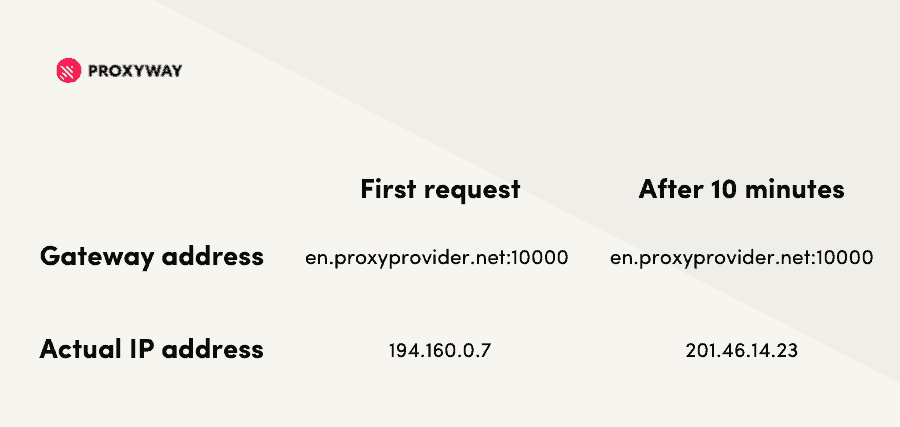What Are Rotating Proxies? A Comprehensive Guide
Rotating proxies automatically give you IPs from a large pool of addresses, making any web scraping project much easier. This page will teach you more about rotating proxy servers, how they work, and when it’s a good idea to use them.

What Are Rotating Proxies?
Rotating proxies are middlemen IP addresses that constantly change. As a result, you get a different IP every five, 10 minutes, or each connection request. The exact configuration depends on your proxy provider.
Why Use Them?
Like every proxy server, anonymous rotating proxies change your IP address and location, effectively giving you a new identity. However, they’re especially useful when you need to make many connection requests quickly. That’s because most websites limit how often you can access them from the same IP address: cross the line, and you’ll start experiencing request throttling, CAPTCHAs, or outright IP bans.
A rotating proxy server automatically swaps out your IP address with a new one. And then again. And again. This way, you never reach the imposed limit, and your web scraper can work uninterrupted.
Compared to proxy lists, they’re simpler to manage. You also get to access a much larger pool of addresses that the provider updates without you needing to pay for more IPs.
How Backconnect Rotating Proxies Work
Rotating proxies don’t give you a list of IP addresses. Instead, you get one address called a backconnect gateway server. This server functions as a doorway to a provider’s proxy pool: it automatically fetches you new IP addresses, without you needing to do anything.
Note that providers usually assign rotating proxies from one or several IP pools, which multiple people use at the same time. Thus, you’re effectively getting a shared proxy service, with all it entails: some IPs can be slower, others banned by your target domains. That’s the price you pay for convenience. To get dedicated rotating proxies, you’ll have to set up proxy rotation by yourself or use tools offered by some providers (like Oxylabs’ Proxy Rotator or Bright Data’s Proxy Manager).
The Main Rotating Proxy IP Types
The term rotating proxies mainly defines the proxy server’s behavior and format. However, it doesn’t define the IP source. Knowing this, you can get several types of rotating IPs, depending on where they come from. Each kind varies by effectiveness and price.
Rotating Datacenter Proxies
Rotating datacenter proxies are created by web hosting companies and held in servers. They offer fast connection speeds and nearly 100% uptime. They also cost less than residential or mobile IPs because they’re easier to source. However, datacenter proxies are relatively easy to identify, which makes them struggle with protected websites like Google or Amazon.
Rotating Residential Proxies
Rotating residential proxies borrow IPs from real devices on Wi-Fi scattered throughout the world. They’re slower, more expensive, and less predictable than datacenter proxies. But they’re very hard to detect. This type is best for accessing well-protected websites or doing tasks that require precise location targeting.
Rotating Mobile Proxies
Rotating mobile proxies borrow IPs from phones and tablets on 3G/4G/5G connections. They’re the slowest and most expensive option, but also one that’s hardest to detect. You can use mobile IPs with almost any target without fear of blocks thanks to the IPv4 shortage. Mobile proxies are often an overkill for web scraping tasks.
Use Cases
Put simply, rotating proxies work best when you need to make a large number of connection requests to a domain. This covers a wide range of web scraping tasks. Here are a few concrete use cases:
- SEO monitoring – Google imposes strict limits on the number of searches you can make, so you need to continually switch IP addresses to avoid CAPTCHA prompts. Marketers use rotating proxies to research keywords, track ranks, and run SEO audits on websites. For instance, they can collect the People Also Ask boxes for content ideas.
- Price aggregation and comparison – price aggregators compare data from e-commerce, travel, and other websites to present the best deals (and make some money via affiliate links). Skyscanner is so useful for finding flights because it constantly collects information from dozens of airlines.
- Collecting product data – companies scrape e-commerce stores to get product descriptions, images, reviews, track and respond to pricing changes. Amazon makes a particularly useful target for this use case, and it’s impossible to extract meaningful amounts of data from it without a network of rotating proxies.
Any Use Cases to Avoid?
Rotating proxies aren’t ideal when you need to keep the same session. It includes logging in, storing cookies, or going through a multi-step form. This is easy to overcome if your provider allows to control the rotation interval, for example, make it 10 or 30 minutes. It’s called a sticky session.
Rotating proxies are also problematic when you need a consistent long-term identity. This includes managing social media or e-commerce accounts.
Comparing Rotating vs Static Proxies
The obvious difference between rotating and static IP addresses is that the former rotate and the latter don’t. This implies that rotating IPs are better when you need to constantly change IP addresses and worse when you don’t.
It’s a good rule of thumb to follow, but the reality is more nuanced. For example, it can make sense to get static datacenter proxies if you know what you’re doing and don’t mind setting up IP rotation by yourself. This will give you fast and dedicated IPs for a significantly lower price.
In the same way, rotating proxies with sticky sessions are actually popular for things like social media automation. That’s because they require a high level of anonymity, and most residential or mobile proxies that provide it have to rotate by design.
Learn more: Static vs Rotating Proxies
How to Use Rotating Proxies
Though terms like backconnect gateway address might sound intimidating, using rotating proxies is actually pretty easy.
They normally take the following format: en.proxyprovider.net:10000. It’s the same as the regular IP:port format, only looks nicer. You can enter this address into your web scraper or automation software like you would any other proxy IP.
Let’s consider two scenarios:
- Your provider rotates IPs every connection request. In this case, you can simply ping the gateway server multiple times, and each time, you’ll get a new IP address.
- Your provider rotates IPs every ten minutes. In this case, an IP address will likely be bound to the port number. To use multiple proxies at once, simply change the port.

Pros & Cons of Rotating Proxy Servers
Like everything in life, rotating proxy servers have their benefits and drawbacks.
Pros
- Easy to use for web scraping – with a backconnect proxy server, you won’t need to worry about managing lists or setting up IP rotation manually. Simply plug it in and scrape away.
- Very scalable – providers control thousands to millions of proxy addresses in their pools, especially if they sell residential IPs. You can instantly scale up or down as needed.
- Highly diverse – large pools of rotating IP addresses naturally provide a wide variety of subnets and ASNs. This is very hard to replicate with neat ranges of static IPs.
Cons
- Unpredictable IP history – with rotating proxy servers, it’s almost impossible to know if the next IP will work with your target website. Providers with big IP pools mitigate this issue to some extent.
- Traffic-based pricing – rotating proxy providers often charge by traffic, especially for residential and mobile IPs. This can make web data extraction quite expensive if you’re scraping many heavy webpages.
- Forced rotation – sometimes, you might want to have a static IP address, and 10 or 30-minute IP rotation will still be too frequent for the task.
Picking a Rotating Proxy Service Provider
If you’ve decided you need rotating proxies, the market is full of providers willing to sell them to you. Some are great, others not so. To save you the trouble, we’ve made a list of the best rotating proxy providers that work great for most web scraping projects. It outlines their main features, so you’ll have an easier time choosing one that works for you.

Frequently Asked Questions About Rotating Proxies
Not really, unless they allow you to keep the same IP for 10, 30, or more minutes. In that case, they’re okay.
Rotating proxies work for sneakers if they let you create a sticky session. This way, you can use the same IP address until you complete the checkout process. Proxies that rotate every connection request won’t work.
Both static and rotating proxies work for Supreme, as long as they’re residential and let you keep the same IP throughout the checkout process.